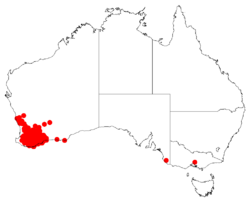Biology:Isopogon teretifolius
| Nodding coneflower | |
|---|---|

| |
| Scientific classification Error creating thumbnail: Unable to save thumbnail to destination
| |
| Kingdom: | Plantae |
| Clade: | Tracheophytes |
| Clade: | Angiosperms |
| Clade: | Eudicots |
| Order: | Proteales |
| Family: | Proteaceae |
| Genus: | Isopogon |
| Species: | I. teretifolius
|
| Binomial name | |
| Isopogon teretifolius | |

| |
| Occurrence data from Australasian Virtual Herbarium | |
| Synonyms[1] | |
|
List
| |
Isopogon teretifolius, commonly known as nodding coneflower,[2] is a species of flowering plant in the family Proteaceae and is endemic to the southwest of Western Australia It is an erect shrub with cylindrical, sometimes branched leaves, and flattened-spherical heads of hairy pinkish flowers.
Description
Isopogon teretifolius is an erect shrub that typically grows to a height of 0.5–2 m (1 ft 8 in–6 ft 7 in) and has hairy, pale to greyish-brown branchlets. The leaves are cylindrical, 25–100 mm (0.98–3.94 in) long, sometimes pinnately divided, the leaf and segments 1.5–2 mm (0.059–0.079 in) wide with a sharply-pointed tip. The flowers are arranged on the ends of branchlets in sessile, flattened-spherical, sometimes dropping heads 25–40 mm (0.98–1.57 in) in diameter with hairy, reddish brown, egg-shaped involucral bracts at the base. The flowers are hairy, creamy pink, pale pink or white tinged with pink, and up to 15 mm (0.59 in) long. Flowering occurs from August to November and the fruit is a hairy nut, fused with others in a flattened-spherical to conical head 20–25 mm (0.79–0.98 in) in diameter.[2][3]
Taxonomy
Isopogon teretifolius was first formally described in 1810 by Robert Brown in Transactions of the Linnean Society of London.[4][5] The specific epithet (teretifolius) means "terete-leaved".[6]
Distribution and habitat
Nodding coneflower grows in forest, shrubland and heath and is widely distributed in the Avon Wheatbelt, Esperance Plains, Geraldton Sandplains, Jarrah Forest, Mallee and Swan Coastal Plain biogeographic regions in the south-west of Western Australia.[2][7][8]
Conservation status
This isopogon is classified as "not threatened" by the Government of Western Australia Department of Parks and Wildlife.[2]
References
- ↑ 1.0 1.1 "Isopogon teretifolius". Australian Plant Census. https://biodiversity.org.au/nsl/services/apc-format/display/101414.
- ↑ 2.0 2.1 2.2 2.3 "Isopogon teretifolius". FloraBase. Western Australian Government Department of Parks and Wildlife. https://florabase.dpaw.wa.gov.au/browse/profile/2238.
- ↑ Foreman, David B.. "Isopogon teretifolius". Australian Biological Resources Study, Department of Agriculture, Water and the Environment: Canberra. https://profiles.ala.org.au/opus/foa/profile/Isopogon%20teretifolius.
- ↑ "Isopogon teretifolius". APNI. https://id.biodiversity.org.au/instance/apni/529005.
- ↑ Brown, Robert (1810). "On the Proteaceae of Jussieu". Transactions of the Linnean Society 10: 71. https://www.biodiversitylibrary.org/page/757236#page/79/mode/1up.
- ↑ Sharr, Francis Aubi; George, Alex (2019). Western Australian Plant Names and Their Meanings (3rd ed.). Kardinya, WA: Four Gables Press. p. 322. ISBN 9780958034180.
- ↑ Foreman, David B.. "Isopogon teretifolius subsp. teretifolius". Australian Biological Resources Study, Department of Agriculture, Water and the Environment: Canberra. https://profiles.ala.org.au/opus/foa/profile/Isopogon%20teretifolius%20subsp.%20teretifolius.
- ↑ Foreman, David B.. "Isopogon teretifolius subsp. petrophiloides". Australian Biological Resources Study, Department of Agriculture, Water and the Environment: Canberra. https://profiles.ala.org.au/opus/foa/profile/Isopogon%20teretifolius%20subsp.%20petrophiloides.
Wikidata ☰ Q18082013 entry
 |


